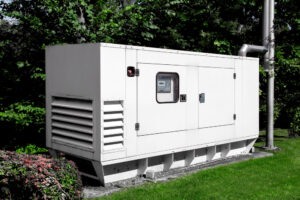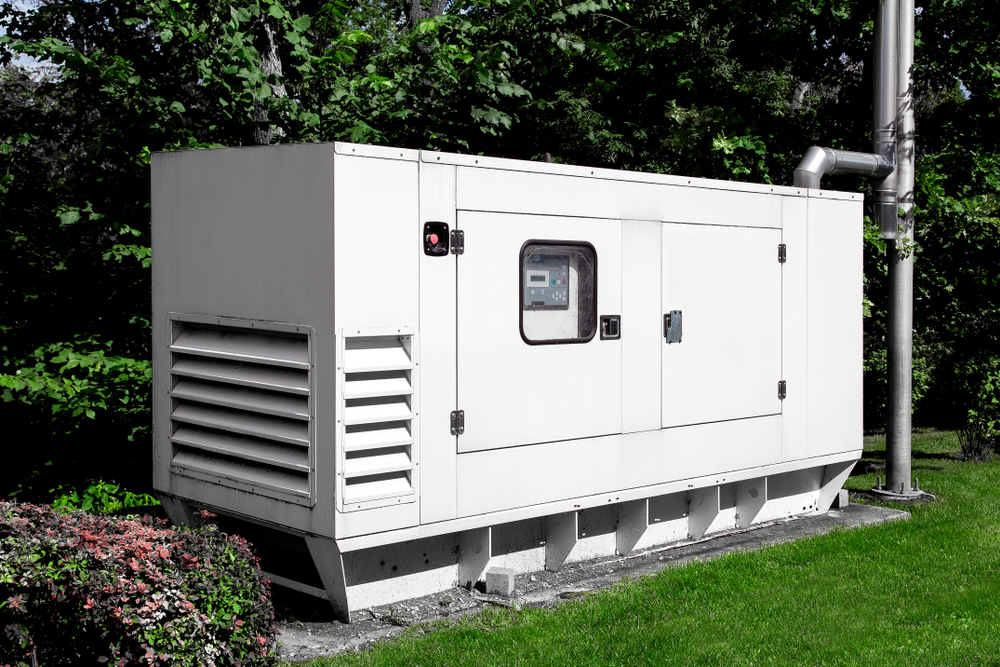 In this article, you’ll discover:
In this article, you’ll discover:- Why mineral wool has been a traditional generator enclosure insulation material and some drawbacks in certain environments.
- The challenges of installing mineral wool insulation for workers.
- The benefits of using hydrophobic melamine foam, especially for outdoor environments that require superior moisture resistance.
In construction, industrial, and other outdoor environments, power generators are a crucial component, especially in remote settings where access to power may be limited. While protective enclosures are effective in shielding equipment from the elements, they are not enough by themselves if the wrong insulation material is chosen.
Most applications require an insulation that can absorb sound, repel moisture, and resist fire and smoke to provide true protection. Mineral wool is a traditional material for generator enclosure insulation, but as this blog post will show, there is a better option for many outdoor environments.
Why Is Mineral Wool Often Chosen for Outdoor Applications
As the name suggests, mineral wool is insulation made from minerals, like stone, silica, and glass cullet. It is used in a wide range of applications, including roof, floor, and wall insulation. Each mineral type offers slightly varying resistance properties, but mineral wool is generally known for the following benefits:
Thermal Control: Mineral wool has low thermal conductivity from its fibrous structure. It can withstand temperatures up to 1000℃ for stone. Mineral wool also provides excellent fire resistance and is classified as non-combustible under ASTM E136. It has a high melting point and will not produce significant smoke or toxic gases if there is a fire.
Acoustic Absorption: Mineral wool’s dense fibers enable it to trap sound waves across frequencies, effectively reducing noise pollution. It is also good at damping vibrations that could impact the system’s performance.
Where Does Mineral Wool Have Some Drawbacks?
Installing mineral wool can be very labor-intensive in insulation applications. Cutting and sizing pieces of mineral wool takes significant time and space. It is heavier than other typical insulation materials, and is often more expensive. There have also been concerns that exposure to mineral wool fibers may cause respiratory irritation and temporary skin discomfort. Finally, mineral wool is not as effective for thermal insulation if it’s consistently wet.
In one project for a leading manufacturer of natural gas compression systems, we also had to account for the stud-welding process, which can make installing mineral wool even more costly and inefficient.
Why Hydrophobic Melamine Foam Is a Better Fit for Generator Enclosures Outdoors
An alternative to mineral wool is hydrophobic melamine foam. This flexible material has an open cell structure that allows it to absorb a broad range of sound frequencies while offering excellent resistance to heat and chemicals.
The key difference between hydrophobic melamine foam and melamine foam is its exceptional water resistance, which makes it a preferred option for outdoor applications. Water will bead up on the surface and simply roll off.
In the project referenced above, our engineers selected POLYDAMP® Hydrophobic Melamine (PHM) Foam combined with micro-perforated Reinforced Aluminum Foil facings to support acoustic and thermal insulation without some of the drawbacks associated with mineral wool. We also added a pressure-sensitive adhesive on the backside of the composite for installation. This custom solution was selected for several reasons:
Excellent Moisture and Fire Resistance
PHM is engineered to repel water. For a system exposed to the elements, this ensures the insulation remains effective and durable. Mineral wool is naturally moisture-resistant but does not provide nearly as much protection as PHM. especially in consistently wet environments. Mineral wool needs to dry completely to retain its original insulation value. PHM also has a high resistance to flammability and smoke.
Enhanced Durability and Longevity
The new system features a micro-perforated Reinforced Aluminum Foil facing that reflects radiant heat energy, protects the foam from damage, and allows it to withstand operational stress. The durable film facing also protects the foam against outdoor contaminants that could impact the solution’s performance.
Improved Safety and Efficiency
In addition to custom facings, PHM is flexible enough to accommodate various pressure-sensitive adhesives. We created a streamlined kit with a pressure-sensitive adhesive to eliminate the need for hundreds of stud welds, significantly reducing labor costs and installation time while keeping workers safe.
To address the core performance and installation challenges, we went beyond the limitations of mineral wool and engineered a custom solution. The project’s success was rooted in this combination of hydrophobic melamine foam, custom aluminum foil facings, and pressure-sensitive adhesives, which proved to be a far better option.
Think Outside the Box for Better Insulation Performance
At Polymer Technologies, we provide effective acoustic and thermal insulation solutions for a wide range of power generation applications. While mineral wool is a suitable solution for some projects, it falls short because it is often difficult to install, has some challenges with moisture, and may pose health risks for workers.
If you are looking for a better insulation material to address all your needs, contact the experts at Polymer today. We will deliver a foam solution that provides excellent sound and thermal insulation while also offering the moisture resistance and production improvements your project needs.


